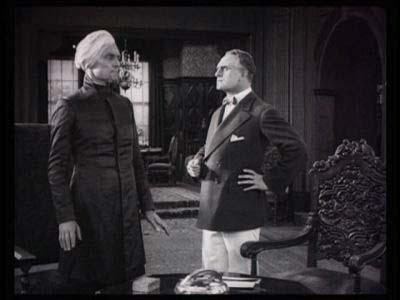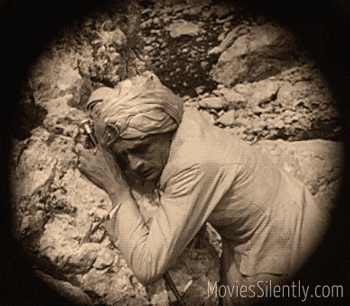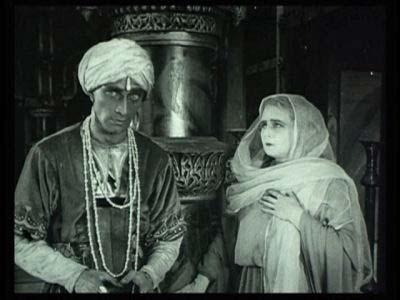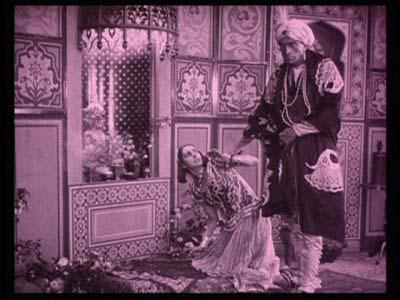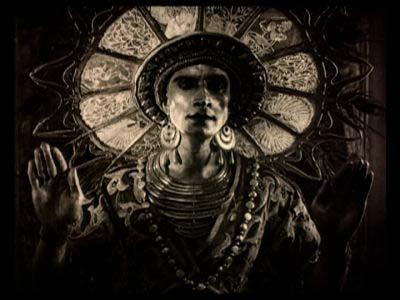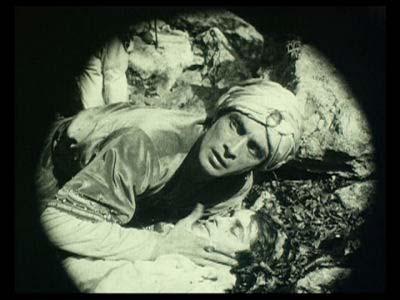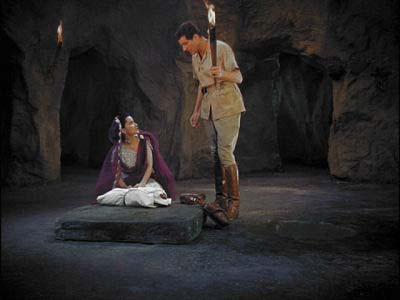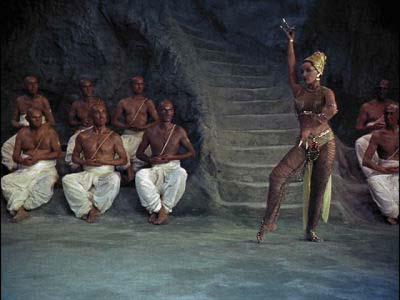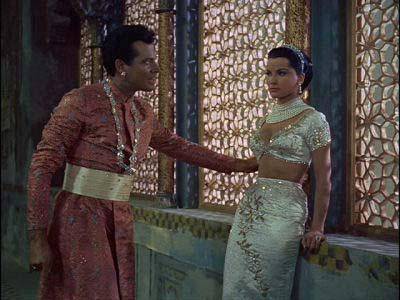The Maharajah of Bengal wants his wife to have the most fabulous tomb in the world. He hires an English architect to design and constructs it. There’s just one little problem. His wife is not dead. Yet. This is a classy adventure yarn with a strong Teutonic flavor. Well worth obtaining.
Home Media Availability: Released on DVD with English intertitles.
Bonus: I will also be reviewing the 1959 talkie version directed by Fritz Lang. Click here to skip to the talkie reviews.
Ah! The balmy climes of Germany!
From Fu Manchu and Charlie Chan to adaptations of Kipling’s novels, popular entertainment of the early twentieth century was obsessed with the East. The heady bodice-ripping of The Sheik, the many film versions of the tragic Madame Butterfly... the West loved to see the East.
After it had been properly sanitized for their protection, of course.
Thea von Harbou, who would later marry famed director Fritz Lang, wrote a novel of Indian love and obsession. Producer Joe May, known for his epics, obtained the rights and created a big-budget adaptation. Elephants and tigers were hired from zoos. Fake palms were planted in the soil of Deutschland and European actors were painted becoming shades of brown.
The Indian Tomb was conceived as popular entertainment, complete with chases, fights, man-eating tigers, crocodiles, holy men wielding mystic powers, and all topped with a lulu of a mad monarch.
Ayan (Conrad Veidt), the spoiled maharajah of Bengal, awakens the yogi Ramigani (Bernhard Goetzke) from his holy sleep. Ramigani has the power to transcend time and space, to read minds, and to grant anyone’s dearest wish.
Ramigani is out to prove that fleshly desires are empty. He grants wishes to show that people only think they know what they want. A study in “be careful what you wish for.”
Ayan wants Ramigani to fetch the English architect Herbert Rowland (Olaf Fønss). The yogi warns the Maharajah that his plans are futile but he does what he is commanded. Ramigani disappears from Bengal. He rematerializes in Herbert Rowland’s living room. There he makes his offer: the Maharajah wishes to hire Herbert to design and construct the most beautiful tomb in the world for his wife.
The catch? Herbert must leave at once and not tell anyone where he is going, not even his fiancée Irene (Mia May, director Joe May’s wife). After some hesitation, Herbert agrees. I mean, who wouldn’t trust this guy?
A little later, Irene stops by to see Herbert. After hearing that he left with an Indian gentleman, Irene begins to investigate. Ramigani uses his powers to block her at every turn but Irene is nothing if not determined and finally figures out where Herbert is going.
May I suggest marriage counseling?
Herbert is greeted royally in Bengal. Ayan shows him to the palace and wants him to begin work on the tomb immediately. It is then that Herbert discovers the ghoulish nature of his assignment:
Ayan’s wife, the princess Savitri (Erna Morena, Veidt’s frequent co-star) is not dead. She was caught having an affair with an English army officer and is a prisoner in the palace. It’s anyone’s guess how and when the Maharajah intends to do her in but hiring someone to build her tomb cannot be a good sign.
Herbert wants to quit on the spot but eventually agrees to stay in Bengal in hopes of softening the Maharajah’s vengeful anger.
Meanwhile, Irene arrives in Bengal and goes to Ayan’s palace to find Herbert. Ayan receives her but refuses to let her distract Herbert from his work.
From her words and actions, Ayan sees how much Irene loves Herbert and it makes him realize how alone he is. The reaction is delicately played, with the Maharajah’s face going from arrogance, to surprise and finally melting into intense loneliness. Conrad Veidt plays the scene almost entirely with his eyes. Large and blue, they may be out of place on a Maharajah but how fabulously they work for the scene!
Ayan does not allow Irene to see Herbert but he allows her to stay in the palace. Her love and devotion for her fiance impressed him so much that he wants to win it for himself.
Ayan’s plan for revenge is almost complete. The only missing component is Savitri’s lover, MacAllen (Paul Richter, looking so handsome that it is easy to see why Savitri took the risk of romancing him). Ayan sends hunters to bring him back to the palace.
Alive, of course. A man keeps a tiger pit for just such an occasion.
Princess Savitri is desperately worried for MacAllen’s safety. She is a prisoner but her maidservant, Mirrjha (Lya de Putti) is free. Savitri sends Mirrjha to Herbert with a message in hope that he will assist a fellow Englishman.
But Bengal is not England and Ayan will not stand for anyone interfering with his revenge…
Bombs Away!
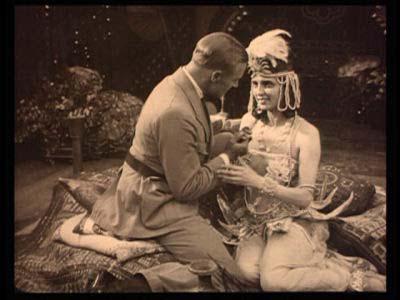
The Indian Tomb is a two-part film. Part One is called The Mission of the Yogi (Die Sendung des Yoghi) and Part Two is The Tiger of Bengal (Der Tiger von Eschnapur).
In spite of its spectacle and large budget, it was a flop when it was released in Europe. The film was edited down to a single feature-length movie, which is how, presumably, it was released in the United States. Largely forgotten, the film received DVD release in 2000 and was received enthusiastically by silent film fans.
Hurrah for Maharajah Veidt!
What makes it so good? The Indian Tomb is a splendid production with no expense spared on the gigantic sets. However, it’s the cast the puts the whole thing over. Two of its biggest assets are Bernhard Goetzke and Conrad Veidt.
Goetzke’s quiet, spiritual yogi is the unwilling tool of the maharajah’s revenge. Goetzke has a strong screen presence and he dominates almost every scene he is in. Featured prominently in the first film, he is relegated to the background for the second. However, his restrained strength remains with the viewer long after the film is over.
Conrad Veidt was often featured in so-called Oriental roles. In the era of the Yellow Peril, villains of Asian descent were the favored baddies of many European and American films. Don’t let that scare you away, however. Veidt’s tasteful performance as Ayan is anything but a cliché.
Ayan may be doing evil things but he is not evil. A pampered ruler who is experiencing heartbreak for the first time in his life, the maharajah still deeply loves his unfaithful wife. His desperate attempts to win Irene’s heart are just an effort to drown his own misery. But, like a spoiled child, he rages and schemes and sometimes destroys the very thing he adores.
The costume design takes advantage of Veidt’s sometimes androgynous appearance, decking him in gems and even painting him gold. No one can pull off a turban and earrings quite as well.
German silent films take their time and it would be impossible to deny that The Indian Tomb opts for a deliberate pace but this does not necessarily mean boredom.
While the more leisurely tempo takes some getting used to – especially to viewers accustomed to the frantic pace of American adventure films of the period… well, any period, actually— it gives clever actors like Goetzke and Veidt a chance to squeeze maximum impact out of their characters.
The carefully crafted suspense and emotional pressure all pay off in the violent final act. The scene where Ayan finally feeds MacAllen to his pet tigers (with a hysterical Savitri watching) is startlingly realistic, with a real tiger enthusiastically munching on the unfortunate Paul Richter. The camera cuts away at the proper moment and no blood is shown but the the sequence is quite convincing. (Richter would once again meet an unfortunate end as the titular Siegfried in Fritz Lang’s Wagnerian epic.)
German heroines of this period are often of, shall we say, valkyrian proportions. In the past, some reviewers have complained about Mia May’s age and weight in The Indian Tomb. This is a bit unfair since May’s character, Irene, is never portrayed as a juvenile nor is Ayan’s attraction to her based on her physical appearance. Besides, Olaf Fønss, who plays Herbert, is neither a sylph nor a spring chicken in The Indian Tomb but no one has complained about him. Double standards, double standards.
Herbert and Irene are both appealing, down-to-earth characters and their appearances reflect that. They are real people, the kind you would like to have as next-door neighbors, trapped in a bizarre adventure. Yet another contrast between the East and the West, at least in the view of the filmmakers.
The Indian Tomb is a curious blend of Germanic filmmaking, the Eurocentric view of India and the emerging pulp action film genre.
The result is a strange, intoxicating hybrid that gives a very satisfying viewing experience. It is dark, sensual and sometimes sadistic but an ultimately fascinating look at humanity’s sinsiter side. In short, everything a fan of Weimar cinema could want.
While not recommended for newcomers to silent film (probably far too stylized and long for most new viewers), The Indian Tomb is an incredibly rewarding movie for devotees of German cinema, serial fans looking for something a little different and Conrad Veidt fans.
Especially for Conrad Veidt fans. Particularly in the climax, Veidt’s performance makes The Indian Tomb worth viewing and re-viewing.
Movies Silently’s Score: ★★★★
Where can I see it?
The Indian Tomb is available on DVD with English intertitles. The print is in very nice shape and the DVD features a synth score from Eric Beheim. This disc is now out-of-print but it’s worth tracking down a used copy. There is also a new German edition available on Bluray but without English subtitles.
Silents vs. Talkies
The Indian Tomb (1921) vs. The Indian Epic (1959)
Ladies and gentlemen, in this corner we have the 1921 Weimar megafilm The Indian Tomb and in that corner we have Fritz Lang’s 1959 Indian Epic, both based on a novel by Thea von Harbou.
Which one of these big-budget German trips through the mystic East will be named champion? Pass the curried sauerkraut and let the fight begin.
The Talkie Challenger: The Indian Epic
Ever had an itch you just can’t scratch? Director Fritz Lang had one and it was called The Indian Tomb.
The silent German original was based on a novel by Thea von Harbou, Lang’s wife. She and Lang co-wrote the scenario for the film. Producer Joe May had hired Lang to direct the picture but abruptly changed his mind and directed it himself.
Depending on who you believe, May either wanted the credit for directing such a prestigious picture or he did not want to trust the expensive project to a new director. Since May was the producer and it was his money at stake, I tend to believe the latter.
However, the fact remains that Lang was deeply disappointed and he apparently carried that frustration for nearly four decades. Lang was determined to remake The Indian Tomb his way. When he returned to Germany after an extended, Third Reich-induced stay the United States, he set to work creating his dream film. Or films. Like its predecessor, The Indian Epic is split into two parts.
To play the object of everyone’s desire, a temple dancer named Seetha, Lang imported Debra Paget. So Paget is an American who plays an Irishwoman who poses as an Indian and is dubbed in German. Got that? Then would you mind explaining it to me?
Lang rearranged the plot a little. The emphasis is placed on the adulterous couple rather than the architect and his wife. And since adulterous couples were not smiled on by the film industry of the 50’s, Seetha is not actually married to the Maharajah (Walter Reyer) yet. This leaves her available for Harald Berger (Paul Hubschmid), a two-fisted architect.
Debra Paget is lovely but I can’t imagine why anyone would think she is an Indian temple maiden. She couldn’t look more American if she had an apple pie tattooed to her fanny.
Speaking of fannies, some of the more memorable scenes of the Indian Epic involve Paget’s holy temple dances. Imagine, if you will, a sacred Hindu ceremony choreographed and costumed by Las Vegas showgirls. Wearing progressively smaller costumes, Paget shimmies her 35-21-35 right into Maharajah Chandra’s heart.
Walter Reyer‘s Maharajah does actually give Conrad Veidt a run for his money, and you must know that I don’t say that lightly. Brooding and lovesick, he mopes wonderfully and slashes a few villains for good measure. His evil brother is planning a coup, you see, and all the good guys are caught in the middle.
Nearly blind, Fritz Lang could still frame a scene beautifully. Mystic smoke, thick jungle, and creepy leper colonies are all filmed to perfection. Unfortunately, moments of beauty are interspersed with artificial-looking sets and cheesy special effects.
And the Winner is…
THE SILENT
With a clearer storyline, better sets and real tigers (as opposed to vaguely tiger-shaped puppets),The Indian Tomb is the clear winner. While it lacks Paget’s kitschy dance numbers, it boasts a stronger cast, better action scenes, an antagonist with a much stronger motivation and considerably more likable heroes. Also a far superior ending.
And it has Conrad Veidt. Yes, the referee is biased.
Also, the storyline, while certainly fanciful, is much more believable in 1921 than in 1959, by which time India was a Republic (though Maharajahs held their titles until 1972).
I know, I know, it’s just a fantasy. Still, the whole things feels like it was filmed in the 30’s and not in a good way. Sheath dresses and horn-rimmed glasses are the only things that jar the audience rather abruptly back to 1959.
Incidentally, when The Indian Epic was released in America, it was brutally cut down from a combined running time of 3 hours and 40 minutes to just over 90 minutes and released as a single film. Needless to say it didn’t make a lot of sense and didn’t do well at the American box office. Some people never learn…
The Indian Epic is available as a DVD set in German with English subtitles and also includes a version with English dubbing. Sadly, this set is out of print but does show up used from time to time.
It is the third German-made go-round of the Grabmal story, with another two-part film series made in 1938. The 1938 films have not been released to the US market and are frankly unlikely to be. Reich cinema is, unsurprisingly, a hard sell these days.
☙❦❧
Like what you’re reading? Please consider sponsoring me on Patreon. All patrons will get early previews of upcoming features, exclusive polls and other goodies.
Disclosure: Some links included in this post may be affiliate links to products sold by Amazon and as an Amazon Associate I earn from qualifying purchases.

